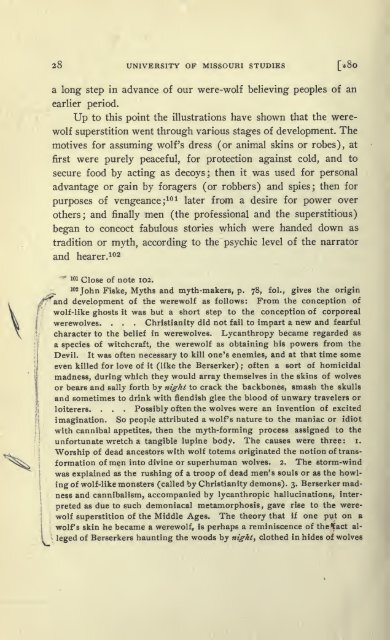origin of were wolf
You also want an ePaper? Increase the reach of your titles
YUMPU automatically turns print PDFs into web optimized ePapers that Google loves.
28 UNIVERSITY OF MISSOURI STUDIES [8o<br />
a long step in advance <strong>of</strong> our <strong>were</strong>-<strong>wolf</strong> believing peoples <strong>of</strong> an<br />
earlier period.<br />
Up to this point the illustrations have shown that the <strong>were</strong><strong>wolf</strong><br />
superstition went through various stages <strong>of</strong> development. The<br />
motives for assuming <strong>wolf</strong>'s dress (or animal skins or robes), at<br />
first <strong>were</strong> purely peaceful, for protection against cold, and to<br />
secure food by acting as decoys; then it was used for personal<br />
advantage or gain by foragers (or robbers) and spies; then for<br />
purposes <strong>of</strong> vengeance; 101 later from a desire for power over<br />
others; and finally men (the pr<strong>of</strong>essional and the superstitious)<br />
began<br />
to concoct fabulous stories which <strong>were</strong> handed down as<br />
tradition or myth, according to the psychic level<br />
and hearer. 102<br />
<strong>of</strong> the narrator<br />
101<br />
Close <strong>of</strong> note 102.<br />
_ 102 John Fiske, Myths and myth-makers, p. 78, fol., gives the <strong>origin</strong><br />
development <strong>of</strong> the <strong>were</strong><strong>wolf</strong> as follows: From the conception <strong>of</strong><br />
<strong>wolf</strong>-like ghosts it was but a short step to the conception <strong>of</strong> corporeal<br />
<strong>were</strong>wolves. . . .<br />
Christianity did not fail to impart a new and fearful<br />
character to the belief in <strong>were</strong>wolves. Lycanthropy became regarded as<br />
a species <strong>of</strong> witchcraft, the <strong>were</strong><strong>wolf</strong> as obtaining his powers from the<br />
Devil. It was <strong>of</strong>ten necessary to kill one's enemies, and at that time some<br />
even killed for love <strong>of</strong> it (like the Berserker) ;<br />
<strong>of</strong>ten a sort <strong>of</strong> homicidal<br />
madness, during which they would array themselves in the skins <strong>of</strong> wolves<br />
or bears and sally forth by night to crack the backbones, smash the skulls<br />
and sometimes to drink with fiendish glee the blood <strong>of</strong> unwary travelers or<br />
loiterers. . . .<br />
Possibly <strong>of</strong>ten the wolves <strong>were</strong> an invention <strong>of</strong> excited<br />
imagination. So people attributed a <strong>wolf</strong>'s nature to the maniac or idiot<br />
with cannibal appetites, then the myth-forming process assigned to the<br />
unfortunate wretch a tangible lupine body. The causes <strong>were</strong> three: i.<br />
Worship <strong>of</strong> dead ancestors with <strong>wolf</strong> totems <strong>origin</strong>ated the notion <strong>of</strong> transformation<br />
<strong>of</strong> men into divine or superhuman wolves. 2. The storm-wind<br />
was explained as the rushing <strong>of</strong> a troop <strong>of</strong> dead men's souls or as the howling<br />
<strong>of</strong> <strong>wolf</strong>-like monsters (called by Christianity demons). 3. Berserker madness<br />
and cannibalism, accompanied by lycanthropic hallucinations, interpreted<br />
as due to such demoniacal metamorphosis, gave rise to the <strong>were</strong><strong>wolf</strong><br />
superstition <strong>of</strong> the Middle Ages. The theory that if one put on a<br />
<strong>wolf</strong>'s skin he became a <strong>were</strong><strong>wolf</strong>, is perhaps a reminiscence <strong>of</strong> the *act alleged<br />
<strong>of</strong> Berserkers haunting the woods by night, clothed in hides <strong>of</strong> wolves


